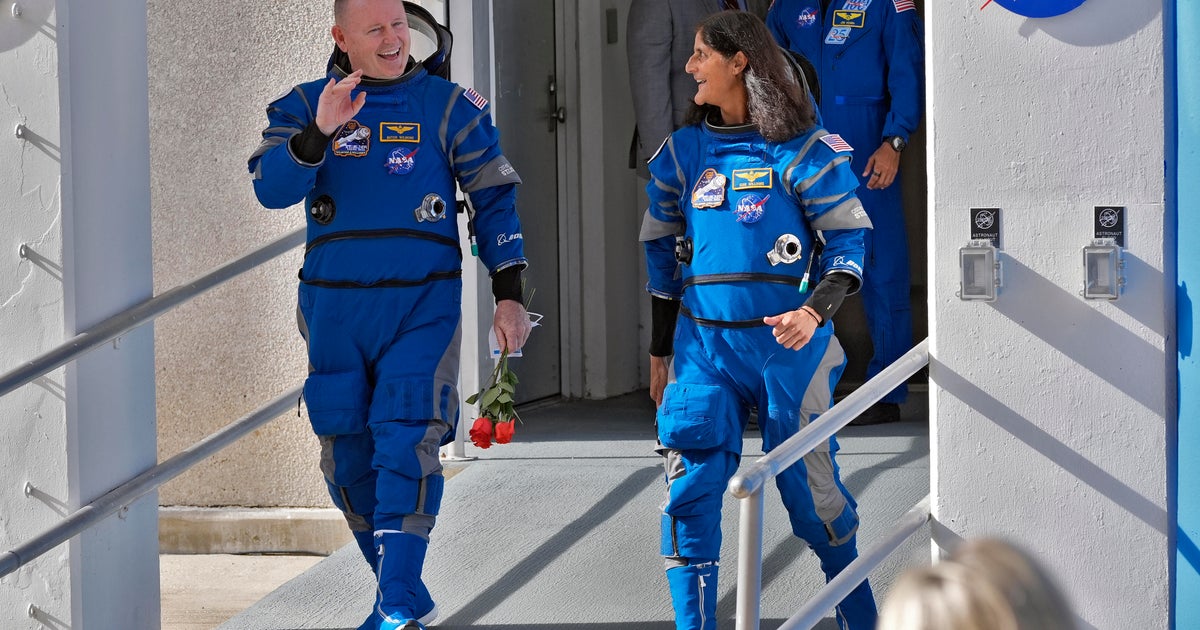CBS News
Boeing Starliner’s first astronaut flight halted at the last minute

The seemingly star-cross Boeing Starliner — within minutes of its long-delayed blastoff on the spacecraft’s first piloted test flight — was grounded again Saturday when one of three redundant computers managing the countdown from the base of the launch pad ran into a problem, triggering a last-minute scrub.
Engineers protectively set up for another launch try Sunday, at 12:03 p.m. EDT, assuming the problem can be resolved in time. A decision was expected later Saturday, after troubleshooters gained access to the suspect hardware and carry out inspections.
The Starliner’s crew, commander Barry “Butch” Wilmore and co-pilot Sunita Williams, came within about two hours of launch on May 6, only to be derailed by trouble with a pressure relief valve in their Atlas 5 rocket, and a helium leak in the capsule’s propulsion module.
Those problems were resolved, and after a few minor snags Saturday, the countdown appeared to be ticking smoothly toward a planned launch at 12:25 p.m. EDT. But 10 seconds after the countdown came out of a planned hold at the T-minus 4-minute mark, the clocks suddenly stopped ticking.
Launches to the International Space Station are timed for the moment the Earth’s rotation carries the pad into alignment with the space station’s orbit, a requirement when trying to rendezvous with a target moving at nearly 5 miles per second. An unplanned hold in the countdown for such missions immediately triggers a minimum 24-hour launch delay.
NASA
Tory Bruno, CEO of United Launch Alliance, builder of the Atlas 5 rocket, said the issue Saturday involved one of three networked computer racks in a building at the base of the launch pad. Each rack features multiple systems, including identical circuit boards that operate together as a “ground launch sequencer,” managing the final steps in a countdown.
The GLS computers manage events like the retraction of umbilicals and the firing of explosive bolts that free the rocket from the pad for takeoff, and all three have to be in perfect agreement for a countdown to proceed.
During Saturday’s launch attempt, the countdown ticked down to T-minus 4 minutes and then entered a planned four-hour hold. When the countdown resumed four minutes prior to blastoff, one of the three GLS circuit boards took longer than expected to synch up with the other two. That was enough to trigger an automatic hold at the T-minus 3-minute and 50-second mark.
NASA
Engineers planned to begin troubleshooting after draining the Atlas 5 of its liquid hydrogen and oxygen propellants and gaining access to the computer room. A decision on how to proceed depended on isolating the problem and replacing and testing any suspect components.
The launch team, while disappointed, took the latest delay in stride.
“You know when you’re playing a game and you get a bad call, you’re a little irritated at first, or a little frustrated at first, but you immediately focus on the next pitch and that’s what our teams do, they’re focused on the next pitch,” said Mark Nappi, Boeing’s Starliner project manager.
“As soon as we went into the launch scrub and launch turnaround, I looked out into the control room and everybody had their heads down, working the procedures to get ready for another attempt tomorrow.”
Said Bruno: “The disappointment lasts for about three seconds. And then you just immediately get busy and do your job. We’ll be back.”
Whenever it takes off, the long-awaited flight will be the first piloted launch of an Atlas 5, and the first for the Atlas family of rockets since astronaut Gordon Cooper took off just a few miles away on the Mercury program’s final flight 61 years ago.
Likewise, it will be the first piloted flight of the Starliner, Boeing’s answer to SpaceX’s Crew Dragon, an already operational, less expensive spacecraft that has carried 50 astronauts, cosmonauts and civilians into orbit in 13 flights, 12 of them to the space station, since an initial piloted test flight in May 2020.
NASA funded development of both spacecraft to ensure the agency would be able to launch crews to the outpost even if one company’s ferry ship was grounded for any reason.
Already running years behind schedule because of budget shortfalls and a variety of technical problems that cost Boeing some $1.4 billion to correct, NASA had hoped to get the Starliner into orbit on May 6. But the launch was scrubbed when United Launch Alliance engineers detected trouble with a pressure-relief valve in the rocket’s Centaur upper stage.
The Atlas 5 was hauled off the pad and back to ULA’s Vertical Integration Facility, where the Centaur valve was quickly replaced. But in the wake of the launch scrub, Boeing engineers saw signs of a small helium leak in the Starliner’s propulsion system.
The leak was traced to a flange in plumbing that delivered pressurized helium to drive one specific reaction control system jet in the Starliner’s service module. The leak was characterized as “very small,” but engineers needed to show it would not drastically worsen in flight and cause problems for other thrusters.
After extensive analysis and testing, mission managers concluded the spacecraft could be safely launched as is, saying that even if the leak rate was a hundred times worse than so far observed, it would not pose a risk to the crew or the mission. As it turned out, the leak rate remained within acceptable limits Saturday.
If the mission can’t get off the ground Sunday, NASA will have two more opportunities next week, one at 10:52 a.m. EDT Wednesday, and the other at 10:29 a.m. EDT Thursday. After that, ULA will have to haul the rocket back to the integration facility to replace batteries in the booster’s self-destruct system. Bruno said that work, if necessary, would take about 10 days.
CBS News
Former Bolivian President Evo Morales claims his car was fired upon in attempted assassination

Former President Evo Morales of Bolivia claimed he survived an assassination attempt on Sunday after unidentified men opened fire on his car. He was not injured and there was no immediate confirmation of the attack from authorities.
Morales alleged the shots were fired while he was being driven in Bolivia’s coca leaf-growing region of Chapare, the ex-president’s rural stronghold whose residents have blockaded the country’s main east-west highway for the past two weeks.
The roadblocks — protesting what Morales’ supporters decry as President Luis Arce’s attempts to sabotage his former mentor and bitter political rival — have isolated cities and disrupted food and fuel supplies.
Morales, who led Bolivia from 2006 to 2019, emerged unscathed from the alleged attack Sunday, appearing on his weekly radio show in his usual calm manner to recount what happened.
He told the radio host that as he was leaving home for the radio station, hooded men fired at least 14 shots at his car, wounding his driver.
Morales was quick to blame his successor, President Arce, with whom he is fighting to be the candidate of governing socialist party in next year’s presidential election. He claimed that Arce’s government resorted to physical force having been unable to defeat him politically.
Juan Karita / AP
“Arce is going to go down as the worst president in history,” Morales said. “Shooting a former president is the last straw.”
Officials in Arce’s government did not respond to requests for comment on the incident.
Cellphone video circulating online shows Morales’ driver bleeding from the back of his head. Morales can be seen in the passenger’s seat holding a phone to his ear as the vehicle swerves and a woman’s voice shrieks “Duck!”
The footage shows the car’s front windshield cracked by at least three bullets and its rear windshield shattered. Morales can be heard saying, “Papacho has been shot in the head,” apparently referring to his driver.
“They are shooting at us,” Morales continues on the phone. “They shot the tire of the car and it stopped on the road.”
Morales’ claim deepens political tensions in Bolivia at a volatile moment for the cash-strapped Andean nation of 12 million.
In June, there was an apparent attempted coup by a rogue military general leading a rebellion, where armored vehicles and troops marched to the presidential palace and tried to force their way into the building. The rebellion retreated after Arce confronted the general, bringing the alleged coup attempt to a head, and ordered him to stand down. The general and other senior officers were later arrested.
Then, last month, Morales led a massive march against the government’s mismanagement of the economy that quickly devolved into street clashes with pro-government mobs. Imported goods are scarce and prices are rising. Drivers wait for hours to fill up at gas stations. The gap between the official and black-market exchange rates is widening.
Earlier this month, the feud between Morales and Arce moved to the courts as Bolivian prosecutors launched an investigation into accusations that Morales fathered a child with a 15-year-old girl in 2016, classifying their relationship as statutory rape.
Morales has dismissed the allegations as politically motivated and refused to testify in the case. Since reports surfaced of a possible arrest warrant against him, the ex-president has been holed up in the Chapare region, in central Bolivia, where supportive coca growers have kept vigilant watch to protect him from arrest.
President Arce accuses Morales of trying to undermine his administration to advance his own ambitions.
CBS News
Open: This is “Face the Nation with Margaret Brennan,” Oct. 27, 2024

Watch CBS News
Be the first to know
Get browser notifications for breaking news, live events, and exclusive reporting.
CBS News
Full interview: GOP vice presidential candidate Sen. JD Vance

Watch CBS News
Be the first to know
Get browser notifications for breaking news, live events, and exclusive reporting.










